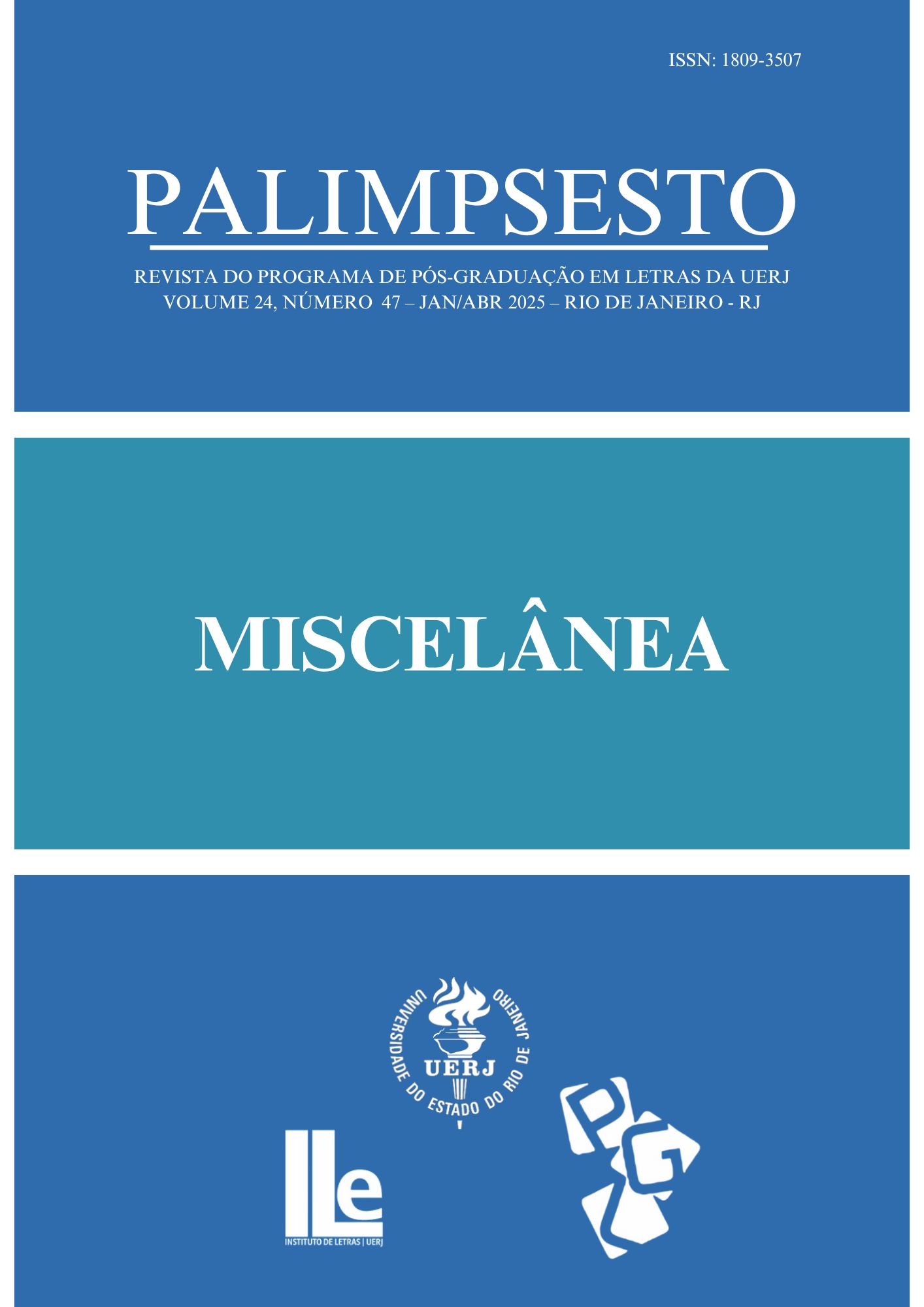Brazilian Songs as a Didactic Resource for Teaching the Phenomenon of Linguistic Variation in Basic Education
DOI:
https://doi.org/10.12957/palimpsesto.2025.85191Keywords:
Linguistic variation, Portuguese Language TeachingAbstract
The aim of this article is to propose the incorporation of Brazilian songs as a didactic resource to promote the teaching of linguistic variation and perception of phonetic-phonological variation in basic education, specifically in high school. To achieve this objective, we conducted documentary research, as guided by Gil (2002). Selecting records of Brazilian songs as a documentary source, accessible online, we prioritized singers/speakers from different regions of the country, such as Luiz Gonzaga, Emicida, Luiza Sonza, Pabllo Vittar, Anitta, Dona Onete, and Gilberto Gil, representing a diverse range of genres, from forró/baião to rap, funk, carimbó to MPB, ensuring regional representativeness of speakers in the five selected songs. For data analysis, we relied on educational sociolinguistic studies, following Bortoni-Ricardo's (2004) guidance, and studies of allophones (phoneme variation), as per Pedrosa and Da Hora (2007). Although there are limitations in documentary research, such as the lack of a survey on the national, regional, and local musical preferences of basic education students, we chose, based on diversity and possibilities of focus, speakers/singers/songs that, in a way, are part of the students/listeners' universe or provide them with new (re)knowledge. We emphasize practical immersion in linguistic diversity, alignment with the BNCC guidelines, stimulation of phonetic-phonological perception, and the creation of a representative educational environment. The research suggests that Brazilian songs in their diversity, interpreted by speakers/musical interpreters from various regions of the country, can constitute productive pedagogical tools for teaching linguistic variation in high school, highlighting a multiplicity of sociolinguistic phenomena.
Downloads
References
BAGNO, Marcos. Preconceito linguístico: o que é, como se faz. São Paulo: Loyola, 2007.
BARREIRA, Sylvia Domingos; MALUF, Maria Regina Variação linguística e alfabetização: um estudo com crianças da primeira série do ensino fundamental. Psicologia Escolar e Educacional, Campinas, v. 8, n. 1, p. 35-46, 2004. Acesso em 30 de agosto de 2023.
BLOOMFIELD, Leonard. Language. New York: Henry Holt, 1933.
BORGES NETO, José. Ensinar gramática na escola? Revel, [s. l], v. 11, n. 7, p. 68-83, nov. 2013. Edição especial.
BORTONI-RICARDO, Stella Maris; BARONAS, Joyce Elaine de Almeida; VIEIRA, Silvia Rodrigues. GT de Sociolinguística e ensino. Revista da Anpoll, [S.L.], v. 52, n., p. 138-156, 27 set. 2021. ANPOLL.
BORTONI-RICARDO. Stella Maris. Educação em língua materna: a sociolinguística na sala de aula. São Paulo: Parábola, 2004.
BRASIL. Ministério da Educação. Base Nacional Comum Curricular. Brasília, 2018.
BRASIL. Ministério da Educação. PNLD 2020:Língua Portuguesa – guia de livros didáticos. Brasília: Ministério da Educação, Secretaria de Educação Básica, 201 p, 2020.
CEGALLA, Domingos Paschoal. Novíssima gramática da língua portuguesa. 48ª ed. São Paulo: Companhia Editora Nacional, 2008.
COAN, Márluce; FREITAG, Raquel Meister Ko. Sociolinguística variacionista: pressupostos teórico-metodológicos e propostas de ensino. Domínios de Lingu@gem, v. 4, n. 2, p. 173-194, 27 fev. 2011.
COELHO, Izete Lehmkuhl; GÖSKI. Maria Edair; SOUZA, Christiane Maria Nunes de.; MAY, Guilherme Henrique. Para conhecer a Sociolinguística. São Paulo. Contexto, 2018.
DUCROT, Oswald. Provar e dizer: linguagem e lógica. Trad.: Maria Aparecida Barbosa; Maria Fátima Moreira; Cidmar Pais. São Paulo: Global, 1981.
FREITAG, Raquel Meister Ko. O desenvolvimento da consciência sociolinguística e o sucesso no desempenho em leitura. Alfa: Revista de Linguística (São José do Rio Preto), [S.L.], v. 65, n. 0, p. 1-27, maio 2021. UNIFESP (SciELO).
GIL, Antonio Carlos. Como elaborar projetos de pesquisa. 4 ed. São Paulo: Atlas, 2002.
GONZALEZ, Lélia. Racismo e sexismo na cultura brasileira. Revista Ciências Sociais Hoje, [S.L], ANPOCS, p. 223-244, 1984.
LABOV, William. Padrões sociolinguísticos. Tradução de Marcos Bagno, Maria Marta Pereira Scherre, Caroline Rodrigues Cardoso. São Paulo: Parábola, 2008.
MENDES, Ronald Beline. Novas maneiras de analisar a percepção sociolinguística. Revista de Estudos da Linguagem, [S.L.], v. 27, n. 4, p. 1581, 11 out. 2019a. Faculdade de Letras da UFMG.
MENDES, Ronald Beline. O efeito de múltiplas variáveis na percepção sociolinguística. Guavira Letras, [s. l], v. 15, n. 31, p. 108-123, dez. 2019b.
MOLLICA, Maria Cecília; BRAGA, Maria Luiza. Introdução à Sociolinguística: o tratamento da variação. São Paulo: Cortez, 2008.
MOREIRA, Roniela Almeida; CARMO, Beatriz Santana do; SILVA, Maria da Guia Taveiro. Análise da variação linguística em fachadas comerciais como proposta de letramento. Philólogus, Rio de Janeiro, v. 78, n. 26, p. 839-853, dez. 2020.
NASCIMENTO, Gabriel. Racismo linguístico: os subterrâneos da linguagem e do racismo. Letramento. Belo Horizonte: Letramento, 2019.
PEDROSA, Juliene Lopes Ribeiro HORA, Dermeval da. Análise do /S/ em coda silábica: uma proposta de
hierarquização dos candidatos gerados. Revista Virtual de Estudos da Linguagem – ReVEL. Edição especial n. 1, 2007. ISSN 1678-8931.
SEARA, Izabel Christiane; NUNES, Vanessa Gonzaga; LOZZAROTTO-VOLCÃO, Cristiane. Fonética e fonologia do Português Brasileiro. Florianópolis: LLV/CCE/UFSC, 2011.
SOARES, Magda. Alfabetização e letramento. São Paulo: Contexto, 2007.
Downloads
Published
How to Cite
Issue
Section
License
Palimpsesto journal publishes original articles and reviews in the field of Literature, Language and Linguistics. We also publish mixed and/or thematic issues, with articles and reviews in Portuguese, English, Spanish, and French.
Authors retain copyright and grant the journal the right of its first publication, with the work simultaneously licensed under Creative Commons Attributions License, which allows sharing of the work with an acknowledgement of authorship and initial publication in this journal.

Palimpsesto uses a Creative Commons - Atribuição-NãoComercial 4.0 Internacional license.







